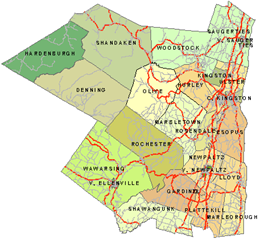Early Ulster County History

“Second only to New York and Albany in antiquity, Ulster County, from the earliest period, was the theatre of important and romantic events.” The value of its location was known to red man and white and fought for. Within its bounds was the first constitution of the Empire State framed, the first constitutional Governor inaugurated, and the first grand jury empaneled by the first Chief Justice. Or from the standpoint of today, this county is the entry-way to one of the popular summer districts of the East, Iying as it does, between, and in, the region of the Catskills and the Shawangunks, and on the Hudson.
Then there is the Ashokan Reservoir, one of the greatest efforts ever made to supply a city with water. In the heart of Ulster, a lake has been impounded, whose surface is more than the whole of Manhattan Island below 110th Street, and whose waters supply more than half that used by the Metropolis. The reservoir was put into use in 1917, at a cost, for all parts of the system, of more than $150,000,000.
The settlement of the county is a marvel of Dutch perseverance, for they established a trading post at Rondout, in 1614, with a few families nearby, only to be broken up by the Indians. In 1630-40 the attempt was made again, only to be destroyed by the Indians, in 1655, but by 1660 settlers had again located in the region. When the treaty, made with the tribes in the latter year, was immediately broken, the whites combined forces and almost utterly destroyed the Ulster Indians. It was during this war that the beauties of the Wallkill valley were discovered, which led to its colonization by French Huguenots, about 1663. From this period, until the Revolution, the valleys of the streams of Ulster, principally the Rondout, Esopus and the Wallkill, became more and more populated. But the Revolution wiped out the frontier settlements, and the “River” towns were captured by the English, in 1777, and mostly pillaged and burned.
The county is one of the original divisions of the State, erected November I, 1683. Of its great territory it has given in the formation of Delaware in 1797, part of Greene in 1800, Sullivan in 1809, and a piece to Orange in the same year. It still has an area of 1,204 square miles, or 760,560 acres. It is mainly mountainous, or upland, has few minerals of commercial value, except cement rock and bluestone, in both of which materials it once did a very large business. At one time the county was the leader in the quality and quantity of its cement. The most of the land is under farm fence, but to a great extent is left in pasture or hay fields. Dairying has always been an important part of the agriculture. It is a natural fruit country and there are parts of the county where fruit growing is brought to perfection.
Kingston is the shiretown, where the original court buildings were erected in 1684. A new set was built in 1732 which were burned by the British in 1777. The Delaware & Hudson Canal, finished in 1828, gave an outlet for the coal of the Honesdale, Pennsylvania, region and intercommunication with many parts of the county.

